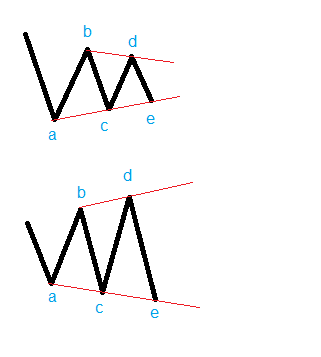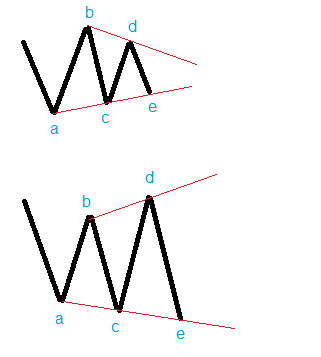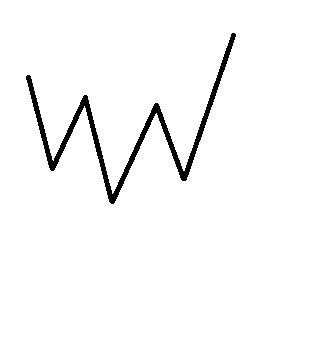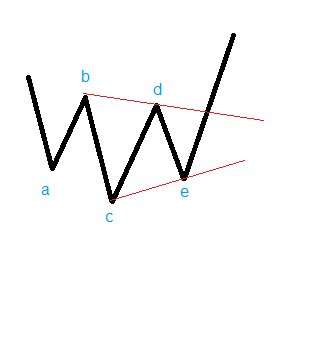Elliott Waves Theory: Different Types of Triangles
Ralph N. Elliott dedicated the last part of his life studying stock market behavior. He firmly believed that the market is the sum of all emotions, and human actions reflect the pessimism and optimism in the market.
Starting from optimism and pessimism, his idea was that the market evolves in cycles, just like human beings have periods of ups and downs, as does the market. He put everything together in what was to become one of the most significant trading theories of them all: the Elliott Waves Theory.
Elliott spent a lot of time in documenting patterns like impulsive and corrective waves. He came out with a set of rules for all possible scenarios that have an impulsive or a corrective wave.
The most challenging part was to interpret corrective waves. Because the market spends most of the time in consolidation (in Forex trading, almost seventy percent of the time the market spends in a range), corrective waves form more often.
It is no wonder he found out many more corrective waves, rather than impulsive ones. He studied all possible corrections (ranges), simple or complex, and mostly he found the forming of triangles.
We already talked about triangles and their frequency in Forex trading, but no other technician made such thorough documentation as Elliott did.
Elliott Triangles in Forex Trading
As corrective waves, triangles appear both as simple and complex corrections. Before discussing their various types, let’s have a quick look at how Elliott defined a triangle:
- It is a three-wave structure, meaning all the segments are corrective
- Despite being called a three-wave structure, it has no more, no less than five segments, all of them corrective
- Elliott used letters to mark the end of each segment: a-b-c-d-e
- The a-c and b-d trend lines give the triangular shape
Contracting and Expanding Triangles in Forex Trading
The two types of triangles depend on the angle of the a-c and b-d trendlines. When the two trendlines contract, they’ll meet somewhere on the right side of the chart.
The meeting point is the Apex of the triangle. On the other hand, when the trendlines expand, the Apex will be on the left side of the chart. More about the Apex and its importance in Forex trading later in other articles in this Trading Academy.
Both contracting and expanding triangles, come in the following types:
1. Horizontal triangles
- A horizontal contracting triangle has all the legs of the triangle smaller than the previous one. As such, a
- An expanding horizontal triangle has all the legs of it bigger than the previous one. Thus, a>b>c>d>e

2. Irregular triangles
- Irregular contracting triangles. Looks similar to the horizontal contracting one, with the exception that the b-wave is the longest of the five segments
- Irregular expanding triangle. In this case, the b-wave is the shortest of the five segments

Elliott also distinguished between various variations of triangles, both expanding and contracting, but they form so rarely in Forex trading that it isn’t worth mentioning them. Keep in mind that the Elliott Waves Theory was developed in the 1940’s, mostly on the stock market.
Later, in the 70’s, other technicians tried to adapt it to the new market’s reality and volatility. Still, Forex trading wasn’t available for the masses, and even historical prices on main currencies were a rarity.
Therefore, today’s reality tells us that the forming of expanding triangles in Forex trading is extremely rare. Instead, horizontal contracting and irregular triangles come up often and are the favored way the market consolidates.
Special Types of Triangles
Elliott found that sometimes triangles appear in such complicated shapes, that other technicians chose to document them as different patterns. For example, we treated here in the Trading Academy one of the most popular and influential reversal patterns: the head and shoulders.
In Elliott’s eyes, the head and shoulders is a contracting triangle. Not one of the triangles mentioned above, but a particular type of triangle.
Elliott found some “irregularities” in triangular shapes that affect the a-c trend line. As a rule of thumb, between the two trendlines of a triangle, the b-d is the most important one, as it shows the end of the triangle.
As such, the special types of triangles refer to the way Elliott replaced the a-c trendline. It did that, by founding triangles in the a-e or c-e baseline.
In other words, while keeping the b-d trendline’s rules, he adapted the original a-c to keep the triangular shapes.
Coming back to the head and shoulders pattern, what’s this if not the purest representation of a head and shoulders:

Yet, in Elliott’s eyes, this is nothing but a triangle. A contracting one:

It is no less than a wonder how Elliott managed to put everything together in a time when Personal Computers (PC) didn’t exist. The beautiful part of the theory is that after almost three-quarters of a century, we can use the method to forecast future prices in Forex trading.
Limiting and Non-Limiting Triangles in Forex Trading
Elliott found that some triangles have a unique function: they either show a limited price action to follow or an unlimited one.
As such, the division into limiting and non-limiting triangles only came naturally. According to Elliott, a limiting triangle forms either as the b-wave of a zigzag or the 4th wave of an impulsive wave.
In both cases, the pattern will end soon. Either the 5th wave of an impulsive move or the c-wave of a flat will complete their respective patterns.
For a limited triangle, look for:
- The b-d and a-c trend lines to be clean, meaning they can’t be pierced by any part of any triangle’s segment
- Under no circumstances, the price doesn’t retest the b-d trend line
For a non-limited triangle, look for:
- The b-d and a-c trend lines must be pierced by parts of any triangle’s segment
- The price does retest the b-d trend line
In the first instance, look for the market to reverse the move that followed the triangle’s break. In the second, look for the new trend to start a new Elliott Waves cycle.
Conclusion
The drawdown of the Elliott Waves Theory is that its disciples adapt it to suit their trading needs. When Elliott laid down the rules for the theory, he studied only the stock market. And some commodities to document different patterns.
These days, there is a saying that ten different Elliott traders will have a different count on the same chart. It is no wonder because the theory was presented in various forms, as to adapt it to the current financial products available to trade.
For some, if you can count five segments, that’s an impulsive move. They quickly forget the need for an extended wave, one that needs to stand out of the crowd. Without an extension, there’s no active impulsive.
For others, the 2nd and 4th waves overlap, forgetting that the Elliott’s original work strictly forbids overlapping in impulsive waves. And the list goes on.
However, every new approach is backed up with new arguments. The best argument is that Elliott Waves won’t work in Forex trading due to the relatively new market, and high volatility levels.
That’s incredibly wrong, and is an excuse for traders that either don’t understand it or don’t have the time to work with it. For one thing is sure: never, in technical analysis history, has another theory interpreted all swings of a financial market, from its conception to current levels.


